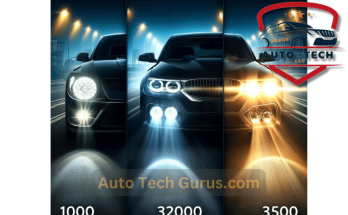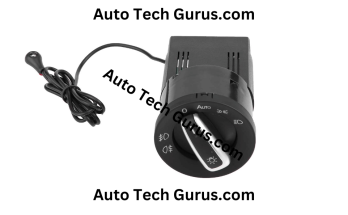Have you ever wondered if your tail lights automatically illuminate when your automatic headlights turn on? This question often puzzles drivers, especially those with newer vehicles equipped with advanced lighting systems. Understanding how your car’s lights function is crucial for safe driving and compliance with traffic regulations.
You must know how your vehicle’s automatic lighting system operates as you navigate various lighting conditions. In this article, you’ll learn about the relationship between automatic headlights and tail lights, explore the science behind these systems, and discover how different vehicles handle lighting in various situations. We’ll also delve into lighting regulations and offer tips to ensure your car’s lights work correctly, keeping you safe on the road.
The Science Behind Automatic Headlights
Light sensors and how they work
Automatic headlights use light sensors to determine the ambient light levels around your vehicle. These sensors are typically located on the dashboard or near the windscreen. They work by detecting the amount of light in the environment and sending this information to the vehicle’s control module.
The sensors can be of two types: photoresistors or solar cells. Photoresistors change their resistance based on the light hitting them. At the same time, solar cells generate electricity when exposed to light. The more light hits these sensors, the stronger the electrical signal they produce.
Integration with vehicle computer systems
The data from the light sensors is processed by the vehicle’s computer system, often referred to as the Powertrain Control Module (PCM) or Electronic Control Unit (ECU). This computer acts as the “brain” of your vehicle, making decisions based on the input it receives from various sensors.
When the light levels fall below a certain threshold, the computer signals the headlights to turn on. Conversely, when light levels rise above the deactivation threshold, the computer turns the headlights off. There’s usually a built-in delay in the system to prevent rapid switching.
Advantages and limitations of automation
Automatic headlights offer several advantages. They make driving easier and safer by ensuring your headlights are on when needed, without you having to remember to switch them. This feature is handy when driving through tunnels or when light conditions change rapidly.
However, there are some limitations to this system. In certain conditions, such as heavy rain or fog, the sensors might not detect the need for headlights if there’s still enough ambient light. Additionally, the system may not respond immediately to sudden changes in light conditions.
It’s important to note that most vehicles with automatic headlights also provide a manual override option, allowing you to control the headlights when necessary.
Tail Light Functionality in Modern Vehicles
Connection to headlight activation
The relationship between tail light activation and headlight operation is fundamental to vehicle lighting systems. In many modern vehicles, automatic headlight systems are designed to activate the headlights when a certain level of darkness is detected. These systems typically turn on all nighttime running lights, including the taillights, just as if you had manually switched on the car’s lights.
However, it’s important to note that some automatic headlight systems may not include tail light activation. This decision could be influenced by various factors, such as legal requirements, energy conservation, and driver preferences.
Variations in tail light design
The tail light design has evolved significantly over the years, with various configurations and technologies being employed to enhance visibility, aesthetics, and energy efficiency. One notable advancement was the introduction of LED (light-emitting diode) tail lights, which have gained tremendous popularity in the automotive industry.
Energy-saving LED technology
Adopting energy-saving LED technology in tail lights has become increasingly common, offering numerous benefits over traditional incandescent bulbs. LED tail lights improve fuel economy by putting less strain on the vehicle’s electrical system. This efficiency aligns with today’s environmentally conscious culture.
- Energy efficiency: LEDs generate light by moving electrons within a semiconductor material, producing less energy waste as heat.
- Brightness: LED tail lights provide a clear, intense light that’s easily visible even in poor weather conditions.
- Quick response time: LEDs illuminate almost instantly, which can be crucial in preventing accidents.
- Longevity: LED tail lights can last up to 25,000 hours or more, significantly outlasting incandescent bulbs.
Moreover, LED tail lights offer designers and manufacturers more creative freedom. The compact size of LED modules allows for more innovative and unique tail light designs, enhancing the overall appeal of vehicles. LEDs are available in various colors and easily integrated into dynamic lighting systems, creating distinctive and eye-catching effects.
In addition to their aesthetic and functional benefits, LED taillights are also more eco-friendly. They use less energy, which ultimately results in a reduction in vehicle carbon emissions. Unlike incandescent lamps, LEDs don’t contain potentially harmful substances like mercury, making their disposal less detrimental to the environment and human health.
Navigating Different Lighting Conditions
Daytime driving considerations
When driving during the day, you might think lighting conditions are optimal. However, there are situations where you need to use your headlights even in broad daylight. The Department of Motor Vehicles recommends using headlights during the day when adverse weather conditions make it difficult to see, such as rain, snow, sleet, fog, or smoke. You should also turn your lights on rural and mountain roads, narrow two-lane highways, or when road signs indicate a daytime headlight zone.
It’s important to note that many modern vehicles have daytime running lights (DRLs) that automatically activate. However, these are not intended to illuminate the road; they only make your vehicle more visible to oncoming drivers. In poor visibility conditions, it’s crucial to manually turn on your headlights to activate your taillights, making you visible to vehicles behind you and potentially preventing rear-end collisions.
Dusk and dawn challenges
Dusk and dawn are particularly challenging times for drivers. The contrast between the bright sky and the darkened road surface can create visibility issues. To navigate these conditions safely:
- Turn your headlights on before it gets dark when the sun is low in the sky.
- Clean your windshield thoroughly to reduce glare from dirt and road grime.
- Consider using polarised lenses if you wear prescription eyeglasses.
- Turn down your dash lights to improve your eyes’ ability to adjust to the darkened road.
- Increase your following distance to at least four seconds, giving you more time to react to potential dangers.
Nighttime and severe weather precautions
When driving at night or in severe weather, visibility becomes even more critical. Use your low-beam headlights or fog lights (if equipped) when driving in fog. If you don’t have fog lights, stick to your low beams. Remember that fog lights should not be used on clear nights as they irritate other drivers.
In any low-visibility situation, whether it’s nighttime, severe weather, or poor lighting conditions, follow these precautions:
- If you’re having trouble seeing other cars, turn your headlights on. They’re probably having trouble seeing you, too.
- Minimise distractions and focus all your attention on driving.
- Watch for signs of driver drowsiness in vehicles around you, especially at dusk when our brains release melatonin.
- Choose routes that don’t fall directly into the sun during sunrise or sunset.
Following these guidelines allows you to navigate different lighting conditions more safely and reduces the risk of accidents due to poor visibility.
Vehicle Lighting Regulations and Compliance
Current laws on vehicle lighting
When it comes to vehicle lighting regulations, you’ll find that they vary significantly across different regions. The Federal Motor Vehicle Safety Standards (FMVSS) regulate vehicle lighting in the United States.
These standards dictate that your primary forward illumination must come from sealed-beam, HID, or replaceable halogen bulbs in factory-fitted housing. This means that while LED lights are legal for auxiliary lighting, such as fog and off-road lights, they’re not permitted for your main headlights unless they come as original equipment from the factory.
Side marker lights have been mandatory in the U.S. since the 1968 model year. Initially, these could be either a light bulb or a reflector, but since 1970, both a bulb and a reflector have been required on all corners of the vehicle. This requirement enhances visibility from the side, particularly in low-light conditions.
Upcoming changes in lighting standards
The automotive lighting landscape is evolving, with new technologies pushing for regulatory changes. In November 2021, the Infrastructure Investment and Jobs Act was signed into law, mandating amendments to Standard 108 of the FMVSS within two years. This change could pave the way for advanced adaptive headlight systems like those already available in other markets.
Hella, a leading automotive lighting company, has introduced Digital Light SSL/HD systems with matrix LED lights containing 30,000 pixels. These systems provide dynamic headlamp functions and generate light markings for driver assistance, such as lane departure warnings and cycling zone projections.
International variations in lighting requirements
Lighting regulations differ significantly between countries. For instance, while side marker lights are mandatory in the U.S., they’re illegal in Europe. European regulations allowed amber side markers for vehicles less than 6 metres in length only after 1991, with the option for red rear side markers if integrated with the rear light units.
In Canada, the Highway Traffic Act focuses more on properly installing, aligning, and maintaining headlights to prevent glare from oncoming traffic. Regarding tail lights, while LED brake lights are generally permitted in the U.S., Canadian regulations are stricter about modifying tail light colors due to safety concerns.
As you navigate these regulations, remember that compliance is crucial for safety and legal reasons. Always check your local laws before modifying your vehicle’s lighting system, as requirements can vary between countries and states or provinces.
Conclusion
The world of automotive lighting is constantly evolving, with advancements in technology and changes in regulations shaping the way our vehicles illuminate the road. From the integration of automatic headlights with tail lights to the adoption of energy-efficient LED technology, these developments have a significant impact on both safety and driving experience. As we navigate through various lighting conditions, it’s crucial to understand how our vehicle’s lighting systems work and to use them appropriately.
As drivers, we are responsible for staying informed about lighting regulations and ensuring our vehicles comply with local laws. The future of automotive lighting looks bright, with adaptive headlight systems and advanced digital light technologies on the horizon. These innovations promise to enhance safety and provide new features that go beyond simple illumination. By staying aware of these changes and correctly using our vehicle’s lighting systems, we can contribute to safer roads for everyone.
FAQs: Do tail lights come on with automatic headlights?
Do tail lights activate when I use automatic headlights?
Yes, tail lights, the red lights at the rear of your vehicle, activate simultaneously with your headlights. This synchronization occurs whether you switch on the headlights manually or if they are set to operate automatically.
Are tail lights supposed to be on when the headlights are on?
When you activate the headlights, your vehicle’s tail lights should automatically turn on. Note, however, that while tail lights illuminate with the headlights, brake lights only activate when you press the brake pedal. Sometimes, brake lights may function even if the tail lights do not.
Is the headlight switch responsible for controlling the tail lights?
Indeed, the headlight switch controls the tail lights. However, remember that a separate fuse could also be specifically for the tail lights.
Do tail lights illuminate when daytime running lights are on?
No, tail lights do not turn on when daytime running lights (DRLs) are active. DRLs are designed to be less bright than headlights and are not intended for nighttime use. Typically, tail lights only activate when the headlights are on.



